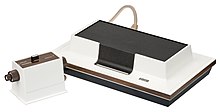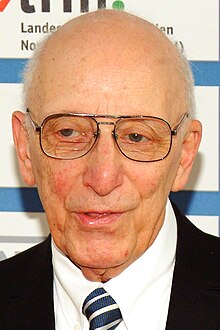Ralph Baer
Ralph Henry Baer (born March 8, 1922 in Pirmasens , † December 6, 2014 in Manchester ) was a German-American game developer. From 1967 he developed the first game console intended for home use , the Odyssey, together with William L. Harrison and William T. Rusch .
Life
Baer grew up in Pirmasens in the Palatinate , where his father owned a tannery, which, however, did not survive the economic crisis after the First World War . Then Baer's father worked as a sales representative for a Pirmasens shoe factory, for which he later moved the family to Cologne . Ralph Baer was partly self-taught. At the age of 14 he had to leave school because he came from a Jewish family . Two months before the Reichspogromnacht (November 9, 1938) he fled with his family to the USA, where he received a correspondence course at the National Radio Institute in radio and television maintenance. After joining the army and participating in World War II , he was trained in algebra in Great Britain - the place where he was stationed . A year after returning from the war, he enrolled at the American Television Institute of Technology ( Chicago ). There he continued his education and received a bachelor's degree in television technology. In 1951 he began to work at Loral Corporation , where he developed, among other things, new television receivers. From 1955, Baer was employed by the military supplier Sanders Associates . There he worked for 30 years, the first 15 years in the field of military projects. He also dealt with transistors and microprocessors .
As a specialist in television technology, Baer thought about additional uses for television sets. So in August 1966 he came up with the idea of developing a game console and games that can be operated via the television set. As one of the department heads at Sanders, he was able to turn his idea into reality. He planned and developed such a device, which he wanted to market for US $ 19.95. He worked with Bill Harrison on the development. They designed a box whose mechanism could control an image that was transmitted from the box to the television. Their first inventions, however, were not yet for entertainment. The first toy they designed was a lever. When this was pressed, a red box displayed on the television turned blue. When Baer presented this invention to the company's board of directors, the latter said that Baer was wasting the company's time.
Since 1967 Bill Rusch also worked with Baer and Harrison. They developed the project further and completed a two-player game. One player chased another in a maze. Finally, they designed a system that displayed moving dots on the screen. Here the player's task was to control one more point that should catch the first. In the end, this resulted in a ping-pong simulation. Baer wanted to market his system. However, Sanders as a company was not suitable for this. The number of employees decreased and as a military supplier they could not operate in the toy market. Then a cable producer, General Electric , Zenith Electronics Corporation , Sylvania and finally RCA appeared as interested parties . Contracts were drawn up but never signed. A former RCA employee sparked interest in this game system at his new employer Magnavox . At Magnavox, the system was slightly revised and produced. From 1972 the game system was sold on the market under the name Odyssey for 100 USD.
In the following years Baer suffered from depression , for which he blamed financial problems of his employer and doubts about the success of his game console.
Baer died on December 6, 2014 in his Manchester, New Hampshire residence at the age of 92.
Honors
- In January 2006, US President Bush honored Baer with the National Medal of Technology for his achievements in the field of technology . This is considered the highest US award in the field of science and technology.
- In 2008 he received the IEEE Masaru Ibuka Consumer Electronics Award .
- For 2014 he was awarded the IEEE Edison Medal .
Steven L. Kent names Baer along with Steve Russel , the inventor of Spacewar! , the "forgotten fathers of video games".
Inventions

- Inside, the rectangular block of wood did not work with computer technology, but with transistors and switches, whereby a matching plastic disc, printed with a playing field, had to be attached to the TV screen to use games, since the console itself could only display the simplest graphic elements . With two rotary controls on both sides, one for the vertical axis, the other for the horizontal axis, you operated your toy figure or a spaceship, etc. The whole thing was structured more like a board game for several people with console assistance; Most of the game variants required additional non-electronic aids such as event cards, etc. Baer presented this device to the then electronics giant Magnavox in the same year , who finally launched the console in 1972 as Magnavox Odyssey in the USA. And this with respectable success. Around 100,000 pieces were sold. This paved the way for the successor device Odyssey 2 - and the game consoles as a whole - on the market.
- Another development by Baer is Senso ( English: Simon ), a well-known electronic musical toy that puts the memory to the test.
literature
- Steven L. Kent: The Ultimate History of Video Games . From Pong to Pokémon and Beyond - The Story Behind the Craze That Touched Our Lives and Changed the World . Prima & Three Rivers, Roseville, New York 2001, ISBN 0-7615-3643-4 .
Web links
Individual evidence
- ^ Gardner Hendrie: Oral History of Ralph Baer. 2006, p. 2.
- ↑ The inventor of the game console returns home. In: Frankfurter Rundschau . June 25, 2008, accessed July 4, 2020 .
- ^ Luke Plunkett: The Father Of Video Games Fled The Nazis, Fought Them Then Took All Their Guns. In: kotaku.com. March 5, 2011, accessed December 15, 2014 .
- ^ Douglas Martin: Ralph H. Baer, Inventor of First System for Home Video Games, Is Dead at 92. In: The New York Times . December 7, 2014, accessed December 15, 2014 .
| personal data | |
|---|---|
| SURNAME | Baer, Ralph |
| ALTERNATIVE NAMES | Baer, Ralph Henry (full name) |
| BRIEF DESCRIPTION | German-American game developer |
| DATE OF BIRTH | March 8, 1922 |
| PLACE OF BIRTH | Pirmasens , Germany |
| DATE OF DEATH | December 6, 2014 |
| Place of death | Manchester , New Hampshire , United States |


